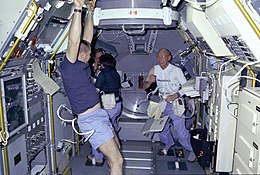
Back STS-51-B Arabic STS-51B Bulgarian STS-51-B Czech STS-51-B Danish STS-51-B German STS-51-B Spanish استیاس-۵۱-بی Persian STS-51-B French STS-51-B Galician STS-51-B HE
 Overmyer, Lind, van den Berg, and Thornton in Spacelab Module LM1 during flight | |
| Names | Space Transportation System-17 Spacelab 3 |
|---|---|
| Mission type | Microgravity research |
| Operator | NASA |
| COSPAR ID | 1985-034A |
| SATCAT no. | 15665 |
| Mission duration | 7 days, 8 minutes, 46 seconds |
| Distance travelled | 4,651,621 km (2,890,383 mi) |
| Orbits completed | 111 |
| Spacecraft properties | |
| Spacecraft | Space Shuttle Challenger |
| Launch mass | 111,980 kg (246,870 lb) |
| Landing mass | 96,373 kg (212,466 lb) |
| Payload mass | 15,610 kg (34,410 lb) |
| Crew | |
| Crew size | 7 |
| Members | |
| Start of mission | |
| Launch date | April 29, 1985, 16:02:18 UTC (12:02:18 pm EDT) |
| Launch site | Kennedy, LC-39A |
| Contractor | Rockwell International |
| End of mission | |
| Landing date | May 6, 1985, 16:11:04 UTC (9:11:04 am PDT) |
| Landing site | Edwards, Runway 17 |
| Orbital parameters | |
| Reference system | Geocentric orbit |
| Regime | Low Earth orbit |
| Perigee altitude | 346 km (215 mi) |
| Apogee altitude | 352 km (219 mi) |
| Inclination | 57.00° |
| Period | 91.50 minutes |
 STS 51-B mission patch  Standing: Lind, Wang, Thagard, Thornton and van den Berg Sitting: Overmyer and Gregory | |

STS-51-B was the 17th flight of the NASA Space Shuttle program and the seventh flight of Space Shuttle Challenger. The launch of Challenger on April 29, 1985, was delayed by 2 minutes and 18 seconds, due to a launch processing failure. Challenger was initially rolled out to the pad to launch on the STS-51-E mission. The shuttle was rolled back when a timing issue emerged with the TDRS-B satellite. When STS-51-E was canceled, Challenger was remanifested with the STS-51-B payloads. The shuttle landed successfully on May 6, 1985, after a week-long mission.